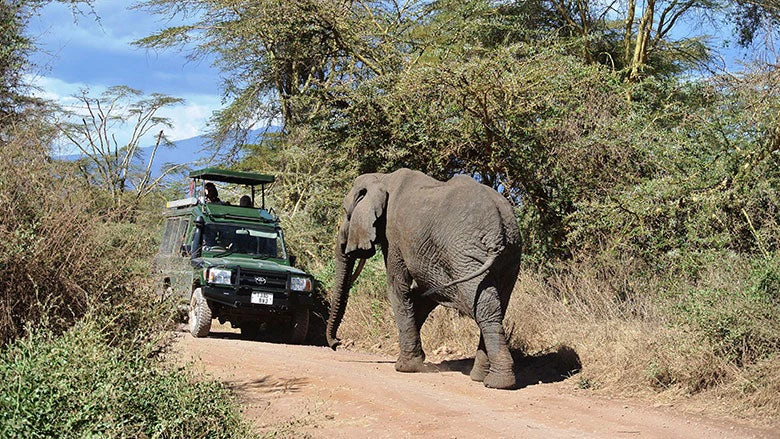
Africa’s unique natural assets—its iconic wildlife, snow-capped mountains, waterfalls, rapids, majestic forests, unique bird populations, pristine beaches and coral reefs—represent tremendous value. Wonders of nature such as Mt Kilimanjaro, Mt Kenya, and the Victoria Falls, as well as Zanzibar’s Stone Town and its beautiful beaches, and the wildebeest migration between the Masai Mara and Serengeti, are some of the world’s best-known tourist attractions.
Indeed, tourism, primarily nature-based in East and Southern Africa, significantly contributes to GDP, jobs, and livelihoods. The World Travel and Tourism Council says that in 2016 the total contribution of travel and tourism was 7.8 percent of GDP and 6. percent of total employment, including its wider effects from investment, supply chain, and income.
In some countries, this contribution is significantly higher. In Namibia, 19 percent of all employment is directly or indirectly linked to tourism. In Tanzania, tourism is the largest foreign exchange earner, competing with gold. Importantly, the spillover effects of tourism throughout the economy can be significant. There is also a strong gender dimension: half of the world’s hotel and restaurant employees are women.
Tourism has been growing faster in emerging and developing regions than in the rest of the world, especially in countries proactively supporting tourism, according to the UN’s World Tourism Organization. Africa is at the forefront of this trend, with the role and value of nature-based tourism likely to increase even more than the global average because of the scarcity of unique wildlife and natural assets.
Nowhere else in the world can tourists experience the same thrill of encounter with wild animals. They can go gorilla trekking in Rwanda, walk with cheetahs in Zambia, observe lions resting in trees in Uganda, or lounge on the pristine beaches of Mozambique’s Maputo Special Reserve while watching wildlife. For this experience, tourists have been willing to pay a premium, and some African countries have been able to corner a high paying niche of the tourism market.
What is needed for Africa to use its huge potential for capitalizing on its natural assets in a sustainable manner?
First and foremost, this requires strong protection and the sustainable management of these assets. Threats such as the rampant poaching of wildlife, the clearcutting of forests, and the pollution of beaches should not only be a concern for environmentalists, but for ministers of finance, planning, and tourism. They should also worry the private sector and local communities, as this sort of damage can deprive them of opportunity. Understanding the value of natural assets and the potential revenues they can generate can help mobilize broad support for protection and conservation efforts.
Investing in protecting a country’s natural assets is equally important for the local and global good.
Role in Protecting Biodiversity
The World Bank has been protecting biodiversity for decades, in the past tenyears through a portfolio of projects worth US$2bn globally, leveraging additional resources. But an urgent response is needed to help people protect against large-scale poaching and illegal wildlife trade.
Many countries have introduced anti-poaching programs and stepped up efforts to curb international networks dealing in the illegal trade of wildlife products, particularly ivory and rhino horn. The World Bank-led, Global Environment Facility-supported Global Wildlife Program, and partnerships such as the International Consortium on Combatting Wildlife Crime, have brought together CITES, UNODC, the Interpol, and the World Customs Organization to help.
Devising sustainable tourism strategies, targets, and plans also helps. Policymakers need to understand that increasing the number of tourists is not always the best target. Other considerations are important, too, such as an ecosystems’ carrying capacity and the need to maintain a unique tourist experience; these attract low impact, high value tourism, especially in areas with unique assets. Revenue per tourist rather than the number of tourists should be used as the benchmark for success. The country’s image should be built, promoted and linked to this vision.
The local economy and local communities need to share the benefits from tourism. There are many opportunities for this, including sourcing supplies and labor, which can be supported by targeted training and capacity building to increase local value addition. My visit to a Bank-supported small training facility in Botswana, one where youth are trained in tourism, showed an uplifting example of what can be done with limited resources. More systematic vocational training can do much more.
Local conservancies have also evolved in countries from Namibia to Kenya to provide sustainable models of community involvement in conservation and tourism. Beyond this, tourism revenue needs to be managed in a transparent and equitable manner to generate broad, local support.
The regulatory environment for businesses to start up and operate needs to be simple and accommodating. Overly comprehensive regulations too often inhibit and discriminate against local business development. Policy reforms can improve the business climate and allow local businesses to thrive.
Investment in services (health, finance, hospitality, safety, and visas) and infrastructure (transport, accommodation, safe water and sanitation) are the basic foundations for attracting tourists. The role of public-private partnerships also needs to be strengthened to ensure that scarce public resources are used for the highest priority public goods, as well as to help leverage private investment.
Nature-based tourism can offer a bright future for Africa. A step in this direction is the US$150m Tanzania Resilient Natural Resource Management for Tourism and Growth Project, the largest nature-based tourism project in the Bank’s portfolio, to be approved by the Board on, September 28, 2017.


Join the Conversation